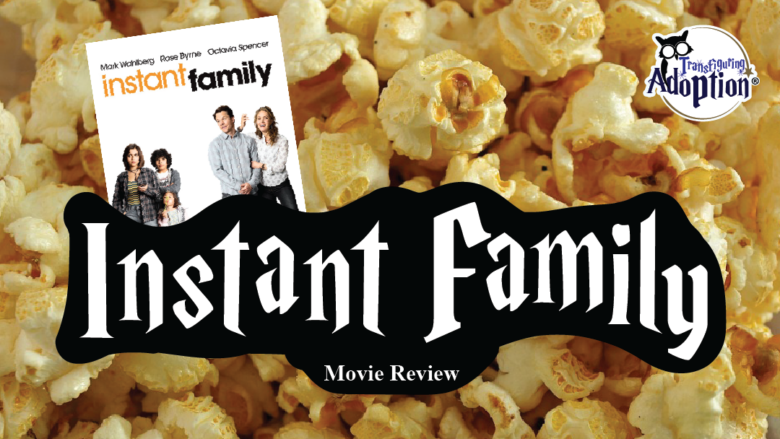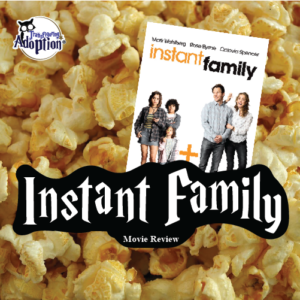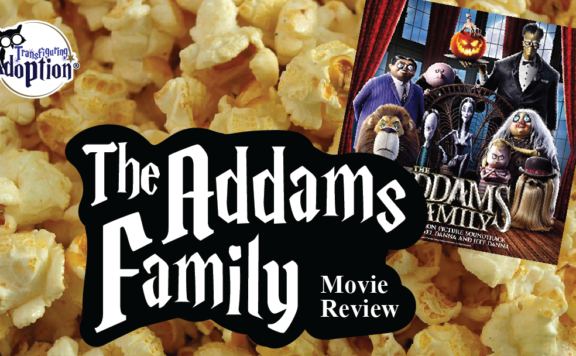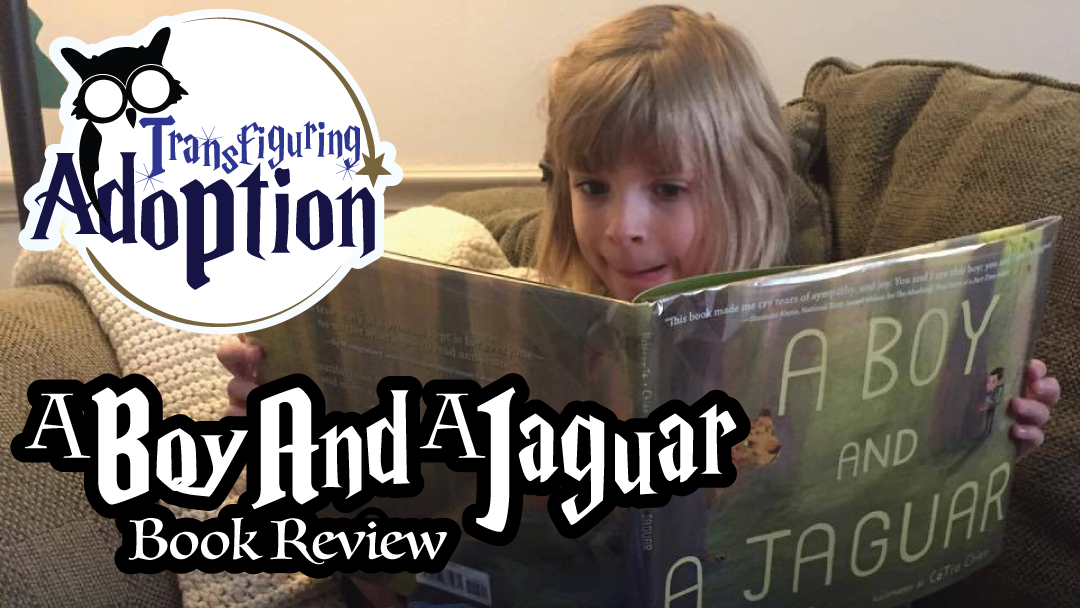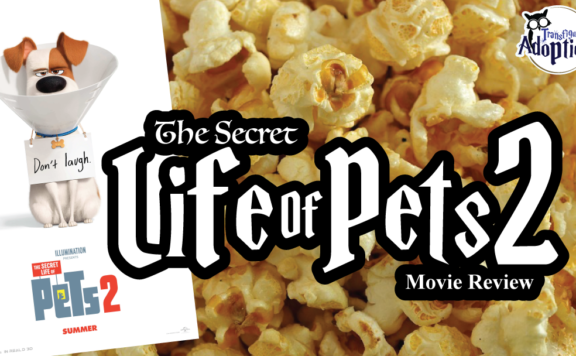Grade:
Transfiguring Adoption awarded this movie 5 Hoots out of 5 based on how useful it will be for a foster/adoptive family. [Learn more about our Hoot grading system here]
From the Cover of Instant Family (2018) by Paramount Pictures:
“When Pete (Mark Wahlberg) and Ellie (Rose Byrne) decide to start a family, they stumble into the world of foster care adoption. They hope to take in one small child but when they meet three siblings, including a rebellious 15-year-old girl (Isabela Moner), they find themselves speeding from zero to three kids overnight. Now, Pete and Ellie must hilariously try to learn the ropes of instant parenthood in the hopes of becoming a family. INSTANT FAMILY is inspired by the real events from the life of writer/director Sean Anders and also stars Octavia Spencer, Tig Notaro and Margo Martindale.”
Movie Info:
- Rating: PG-13 (for thematic elements, sexual material, language, and some drug reference)
- Genre: Comedy
- Runtime: 117 minutes
- Studio: Paramount Pictures
Transfiguring Adoption’s Overview:
Instant Family (2018) is a very unique movie in that it is very clear the team actually talked to people from the child welfare system before and during the process of creating the film. After so many different depictions of the child welfare system and the children within it, it is a refreshing and raw viewing experience that honestly shows the experiences of both foster children and foster parents alike as they navigate all of the challenges that come with family reunification programs, learning to communicate and love within a blended family, and the stark reality of how desperately children in care need a caring adult who won’t give up through naked selfies, food tantrums, and hairbrushes in the toilet. This movie does deal with traumatic elements BUT it is so important how the traumatic elements are not in the driver’s seat for this film. Throughout the film it is reinforced that even when adults are still learning to parent traumatized children that they are able to be bigger, stronger, wiser protectors for the children in their care. For this reason, I highly recommend any family remotely considering adoption or foster care view this film and that current caregivers give this movie a chance for some much needed validation of how tough but worth it caring for children with trauma can be.
There are some intense emotional moments, foul language, and sexual/drug references so this is not a film that should be viewed with children under 12 or 13, but caregivers should very much consider each child in their home even if they are “old enough” as there are several potential triggers in the film that may affect individual youth. This is definitely a film to talk to your youth about after the film and to ensure that you are up to speed on your own state’s child welfare system policies if children ask questions about the fictional policies in the film.
** Spoilers Could Be Ahead **
How Is This Relevant To Adoption & Foster Care?
Instant Family (2018) is probably the most relevant film to adoption and foster care I have reviewed so far in my time with Transfiguring Adoption. I will never forget the first time I heard about this movie from a colleague. She told me of how she found herself recognizing so many family situations working within the child welfare system and hearing the actors use the same terms she was under her breath was surprising and so refreshing. After viewing the film myself I must agree. There are going to be a few things played up for Hollywood suspense of course and the film does play by policies created to further the plot (i.e. – cell phone policy, how visitation was conducted, how courts included children, having the same social workers for classes and case management, etc.) but overall this is the best depiction of a foster parent’s experience in working with the child welfare system. In the United States, this film was actually endorsed by several state child welfare systems and agencies as a recruitment tool and continued education tools.
Discussion Points:
- Grief and Loss
Just the act of being removed from the family of origin and all that is familiar and being placed somewhere else is highly traumatic to children. If we imagine being removed from our everyday life with nothing but the clothing on our backs and being put somewhere else where we had no control over what we ate, what we did, and where we went I think we all would meet the drastic change with some resistance (and in my case, a LOT of resistance whether it was a good change or not)! And this does not even begin to cover all of the other losses and sources of grief a child may have endured as a result of traumatic events. Our children need a caregiver willing to navigate the messy, uncomfortable experience of grief and loss to prepare them for the future when they are older and may have to endure such things on their own. Though it will be tempting to push away these feelings in favor of cheering the child up (as none of us like to see children suffer) it is an important task for a caregiver to quietly accept a child’s pain and help them walk through it so that they do not have to take that emotional journey alone anymore. - Felt Safety vs. Actual Safety & Boundary Testing
For children and youth in the child welfare system, adults are not always viewed as a source of safety and security. Rather, many children have endured adults acting as both the perpetrators of abuse and neglect or as incompetent persons that are incapable of keeping children and youth safe. For this reason an older youth especially will constantly test the caregiver to ensure that the caregiver will provide care and enforce boundaries that promote felt safety. We can see the transition of actual safety to felt safety in each of the children as they adjust to the Wagner home. As routine, structure, and safety is reinforced each of the children are seen letting their guard down and allowing the Wagners to engage as parents. Of course, this process has no straight path and has bumps along the way, but even when it felt like they took a step back with child and youth behaviors it provided an opportunity for new growth and moving forward as a united family. - Behaviors Communicating Need
Throughout the film behaviors were shown by the children as means for them to communicate needs in the only language they knew. Lita is shown acting out over food insecurity and melting down over toys. Juan is shown being impulsive and spaced out, showing where his brain is so overwhelmed that it cannot continue with executive functioning and follow through with tasks without incident. And Lizzie constantly pushes boundaries, triangulates adults, and acts out against her foster mother in her grief for her biological mother in communicating various needs for safety from disappointment, connection with peers, and need for control in her very out of control life. There are so many other examples throughout the film, but it is important for caregivers to practice trauma informed strategies to look beyond the behaviors and see what the hurting child needs under the surface so that they may have that need fulfilled, decrease anxiety and fear, and then learn positive communication skills. - The Identity of a Foster Youth
Lizzie often talks about what other people expect of “fosters”, especially teens like herself. Caregivers should remember that children from the children welfare system often pick up on stereotypes perpetuated by those on the outside and may internalize them as truth and identity. For this reason it is very important for children and youth from the system to have a sense of normalcy for appropriate development (i.e. – extracurricular activities, social opportunities, jobs/volunteer opportunities, etc.) and that caregivers be mindful of how they refer to the children and youth in their home. Caregivers should not use child welfare system terms such as “Level 3 child”, “group home kid”, etc. outside of the child and family team setting for this reason.
Cautionary Points:
- Separation from Birth Parent
Any level of separation from a primary attachment is highly traumatic to a child, especially when separation has become permanent from incarceration of a parent, death of a parent, or the severing of parental rights legally. For this reason, a caregiver needs to be very cautious in allowing a child that struggles with grief and loss in viewing this film as the children depicted are placed with a pre-adoptive home, move back towards reunification, and are then abandoned by a birth parent again. These are things that children from the child welfare system directly struggle with in many cases and a caregiver should be prepared for the emotions a youth may experience from seeing Lizzie’s raw experiences and emotions throughout the process especially, but also for younger siblings Lita and Juan who don’t understand the reunification process. - Foul Language & Use of Negative Stereotypes
Throughout the film youth, foster parents, and case workers are all shown using foul language including, but not limited to, the words “bitch”, “dick”, and descriptions of the male anatomy concerning an issue with Lizzie swapping naked pictures. There are also moments where caseworker Karen grows unprofessional in how she responds to questions from Pete and Ellie concerning the biological family. - Youth Shown Engaging in Risky Behavior
Throughout the film Lizzie engages in troubling behaviors such as runaway, triangulating adults, sneaking friends into the family home, sending naked selfies, pursuing a relationship with an adult man, etc. While several of these depictions are real behaviors children from the child welfare system some youth may struggle with seeing the behaviors if a youth is triggered by viewing an unsafe behavior. - Accidental Harm to Foster Child
Poor Juan throughout the film is shown as a very anxious and accident prone child. Some of these are not as intense such as getting hit in the head with basketballs and footballs but during a particularly intense moment Juan drops a nail gun and shoots a nail into his foot. The injured foot is only shown as having blood seeping through the top of the shoe before being tied up in a shirt and taken to the hospital, but a youth may be triggered by harm coming to a foster youth in a film. - Incidents Involving Foster Parents with Law Enforcement and Home Investigation
While many foster homes do go through foster home investigations due to allegations of various sorts, it is not normal for foster parents to become vigilantes in investigating sexual impropriety between a foster youth and another nor for them to be arrested for any reason. The foster parents should have contacted their caseworker after the incident with the naked pictures with Lizzie arose and should not have pursued the perpetrator and/or assaulted the perpetrator. Watching a foster parent engage in such violence can be highly traumatic for children that have endured trauma as these are the adults they should be learning are safe. This is a point to be cautious with while viewing the film, though it is intentionally overplayed a bit I’m sure for suspense. - Depictions of Courtrooms
Attending court, or even knowing a court appointment is occurring, is often a source of anxiety for children of the child welfare system whether it is due to hoping to go home (like Lizzie) or being afraid of the unknown (like the younger children probably experienced). For this reason, some youth may be triggered by the progress reviews in court though it is not their own case they are watching. - Unsupportive Extended Family
Ellie’s family is shown as extremely unsupportive throughout the film. There is some growth that occurs but some children may have experienced unfair treatment from extended foster families that don’t have the trauma informed care experience and education a foster parent receives.
Discussion Guide:
- What kinds of things do Lizzie, Juan, and Lita worry about while they are in their foster homes?
Caregiver Note: Throughout the film there are many specific worries but overall there are some patterns that persist. Lizzie is especially concerned with trusting adults as so many have failed her, getting back to her mother, and finding acceptance with peers and romantic relationships. Juan is terrified of messing up and reacts with apologies and panic every time he accidentally breaks something and is often so distracted by whatever he is thinking about that he engages in these accidents. Lita is shown struggling with boundaries concerning food and toys due to lacking these things before and being afraid of being uprooted from the Wagner home again after connecting with them. All three of the children have various behaviors related to emotions concerning returning to their mother and with having to leave the Wagner home as well that can be explored. - Why did Lizzie do all her mother’s paperwork for her? Why did she want to go back to her mother even though her mother had not done what she needed to take care of the children?
Caregiver Note: It’s important for caregivers to remember that no matter how maladaptive the relationship that a child has with their biological parent that the biological parent is the very first attachment a child experiences. For this reason children will almost always long for their biological family even when separated for many years. For this reason, and due to being unable to trust her mother to take care of her reunification steps, Lizzie took control of the situation by doing her mother’s paperwork and even speaking for her in court. Caregivers should talk to their children and youth about how it’s okay to care for and love both their biological family and their foster/adoptive family as both have contributed to who they are today. Reassuring a child or youth with both our words and actions as caregivers over time will also help with reducing loyalty conflicts and helping integrate a youth’s sense of identity with their past, present, and future. - How do Lizzie, Juan, and Lita each show they are worried/afraid while they spend time with the Wagners?
Caregiver Note: Lizzie frequently displays her worry through anger, taking control over any situation she can, and shutting others out. Juan often shows worry through his spacing out, fevered apologies, and panicked questions. Lita shows fear through her own attempts to control and manipulate others in addition to her meltdowns. Over time, they each shift into using their words or reaching to the Wagners for support (i.e. – proximity, hugs, etc.) but easily slide back into negative behaviors when under greater stress later in the film. This is very typical of children who have endured trauma as the behaviors from early on have a purpose that once fulfilled need. When afraid or angry it is very hard for children to use reasoning skills in the prefrontal cortex of the brain with the amygdala and hippocampus in the driver’s seat. For this reason it will take months and years of practice for appropriate coping and communication skills to take root, especially in high stress situations. It is a great first step for children to learn how to connect feelings to behaviors and to practice this often to help build on communication and emotional intelligence skills over time. - What are some ways the Wagners helped Lizzie, Juan, and Lita when they were angry, afraid, and worried?
Caregiver Note: There are many ways the Wagners reinforced felt safety in consistency in their responses, meeting each child where they were at emotionally, relating to and validating their fears, maintaining structure and routine that the children could count on, and providing a lot of reassurance when events got intense. Caregivers should note that children who have endured trauma will struggle with engaging in communication in the traditional give-and-take or serve-and-return manner they are used to with other children and that children with trauma will require more serves for interaction than they will receive for a long time. This is because children from the child welfare system often lack the social skills of their peers from their experiences in neglectful situations. For this reason a caregiver will need to keep “serving” interactions and help with emotions even when a child doesn’t immediately respond and allow that child to learn how to “return” a response to the interactions. - Why did the children, especially Lizzie, push the Wagners away when the Wagners tried to take care of them?
Caregiver Note: As we hear in the film, Lizzie and her siblings had been in foster care for over two years and were very much used to being uprooted and shuffled between foster homes… and that’s not even considering how often they may have moved around prior to entering the child welfare system. These children have learned to not get used to their foster homes or get attached lest they experience another painful loss when they move again. For this reason it will take a foster child varying amounts of time to bond with caregivers. Caregivers should be aware that children even within siblings groups will vary in how quickly they may trust or bond with a caregiver and be prepared for this reason. - Why did Lizzie push back so much when the Wagners tried to parent Lita and Juan?
Caregiver Note: As Karen and Sharon discussed with the Wagners, Lizzie had basically parented Lita and Juan for most of their lives. That’s not to say that Lizzie should continue to parent the siblings, but that does explain her behaviors and defensiveness concerning how the children are treated, in loving affections all the way through forms of discipline. Caregivers should recognize that while an older sibling can be a wealth of information from prior to entering the home, they should not continue to parent the siblings in the caregiver’s home. A caregiver can be respectful of the struggle an older sibling has endured as a caretaker, but it’s important to remember that sense of actual safety vs. felt safety. Would you feel safe in a place where someone said they would take care of you and your siblings if they never stepped up? Nope. Like the Wagners did with Lizzie, caregivers will have a period of testing while they prove that the children are safe until an older sibling feels safe enough to allow a caregiver to parent their siblings. - What did Pete and Ellie do that communicated to the children that they were going to take care of them and that Lizzie, Juan, and Lita were safe? What are some things I can do in the same way that will help you feel safe?
Caregiver Note: Allow your youth to flesh this out, as some responses may surprise you. Often it is the little everyday actions in structure and routine that give a youth something to rely on as they build trust in the caregiver, but overall this is a great way to allow your youth to express directly what they need by seeing so many examples in the film. - What kinds of things did Lizzie say people thought about fosters and teens? What kinds of things made Lizzie believe those things about herself?
Caregiver Note: Because of harmful stereotypes in the media and Hollywood foster children (and teens especially) are often depicted as troubled, mean, and unlovable. This stereotype can inadvertently label your child when they are called a “foster child” or by their level of care in the community as, unfortunately, persons in the community will treat a child differently that they believe may be trouble. It is important that caregivers do not use child welfare system terms in relation to their child outside of the child & family team. Lizzie certainly took on these labels as indicated by her expressions given at the adoption picnic. - How did the Wagners help Lizzie to see herself less as a foster and more as her own person?
Caregiver Note: Though these were not spoken of it was shown that the Wagners encouraged Lizzie’s involvement in extracurricular activities like soccer and showed up in support of her practices and games. The Wagners over time also addressed her needs for anger outlets and care (i.e. – going to the house flip, brushing her hair, etc.) to communicate to her that she was a child worthy of love and care, things that parents should provide for their children regardless of legal status. By promoting normalcy inside and outside the home, along with structure and routine and a lot of care, this allowed Lizzie to trust Pete and Ellie in unique relationships, feel safe, and explore parts of her identity outside of the child welfare system. - ACTIVITY: Grandma Sandy Shirts
Caregiver Note: For this activity, gather some plain t-shirts and t-shirt paint from your local craft store and head outside for this messy activity on a nice day. For each shirt work together to put the preferred name for each family member on their shirt (i.e. – the name the children call the caregivers, the child’s name, child’s nickname, etc.) and then swap the shirts to decorate the shirts for one another like the shirt Lizzie got for Grandma Sandy. Keep in mind your child’s favorite colors, if they love glitter, and style as you craft their shirt. You can also allow each child to work on their own shirt and explain how the design reflects themselves if swapping shirts is too much for some siblings. Feel free to wear your shirts on a family outing and create some memories. Together.
NOTE: Inclusion on these lists does not necessarily mean endorsement. Furthermore, with all our resources, we highly recommend you preview them first to determine if there are any trauma triggers that your child may not be ready to handle. Transfiguring Adoption does not intend for its reviewers nor its reviews to be professional, medical or legal advice. These reviews and discussion guides are intended to help parents to better be able to connect and understand their children who come from traumatic backgrounds.
